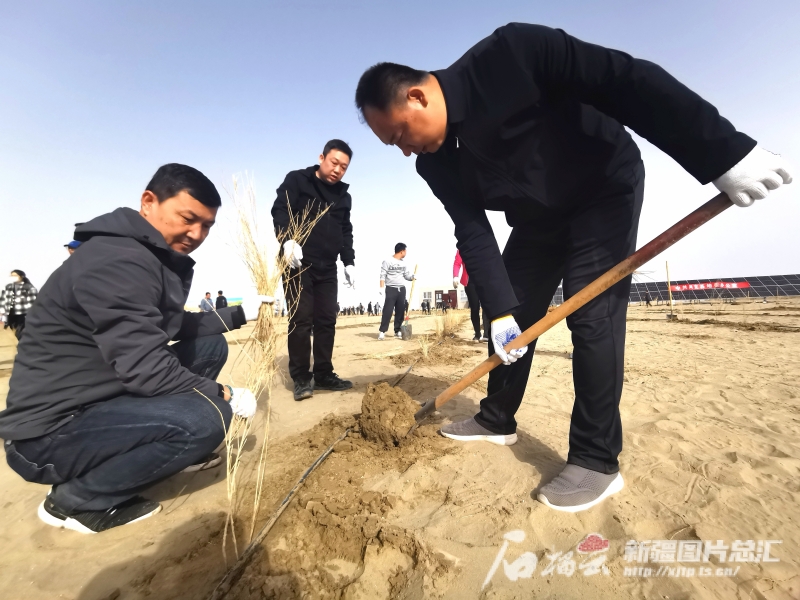Shiliuyun-Xinjiang Daily (Reporter Cao Hua) news: On the morning of March 23, 2024, over 1,300 cadres and people came to the afforestation site in the eastern area of Geizumu Township in Shaya County, Aksu Prefecture, northwest China’s Xinjiang. There, they planted Haloxylon seedlings, also known as Saxaul trees, on the sand. Not far away, rows of photovoltaic panels are in ordered arrangements, and by July this year, a new mode of sand control park featured haloxylon planting supported by photovoltaic power irrigation will be built here.
On March 23, a battle on the edge of the Taklimakan Desert was launched to prevent its further expansion.

Photo shows cadres and people plant Haloxylon seedlings in Geizumu Township, Shaya County, Aksu Prefecture, northwest China’s Xinjiang Uygur Autonomous Region. (Photo by Shiliuyun-Xinjiang Daily/ Cao Hua)
"Today we will plant 100,000 plants of Haloxylon and use photovoltaic power to get water and control desertification," said Wang Kaiyan, deputy director of the Populus euphratica forest protection center of the Forestry and Grassland Bureau of Shaya County. He said that, compared with electrical power, using photovoltaic power to get water for desertification control has advantages of low cost and environmental protection. Taking into consideration that a well can irrigate 2,000 mu (about 133.3 hectares) sandy land, employing photovoltaic power irrigation can save 133,000 yuan (about 18,470 U.S. dollars) in the first year, and 160,000 yuan (about 22,219.84 U.S. dollars) per year from the second year.
In 2023, the Three-North Shelterbelt Forest Program has entered the storming and fortified stage. Aksu Prefecture formulated desertification-control plans and took 12 comprehensive measures including artificial afforestation, trees (grass) planting for sand fixation, straw checkerboard sand barriers, and photovoltaic power generation among other measures to control desertification, to ensure fulfilling all tasks of the battle on the edge of the Taklimakan Desert.
According to the plans, preventing desertification of the oases in Aksu Prefecture is mainly through the construction of farmland shelterbelt forests, restoration of degradation protection forests and other measures to ensure the productive and ecological security of the oases; serious desertification in areas such as Awat County, Kuqa City, Xinhe County and Baicheng County will be controlled through planting shrub shelterbelt forests, sealing off desert areas for afforestation and grassing, engineering sand fixation, photovoltaic power generating + sand control and other measures. Preventing further desertification of the edge of the Taklimakan Desert from keeping encroaching on the oasis will be achieved by means of artificial afforestation, ecological replenishment of Populus eupharatica forest and engineering sand fixation.
Liu Ning, secretary of the leading Party members’ group of the forestry and grassland bureau of Aksu Prefecture, said that Aksu will do its best to fight against the desertification of the edge of the Taklimakan Desert and continuously promote desertification control measures.
(A written permission shall be obtained for reprinting, excerpting, copying and mirroring of the contents published on this website. Unauthorized aforementioned act shall be deemed an infringement, of which the actor shall be held accountable under the law.)









